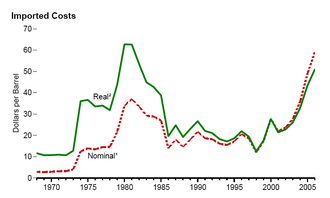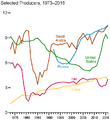1970s energy crisis facts for kids

Real and Nominal price of oil, 1968–2006.
|
|
| Date | 1973–1980 |
|---|---|
| Also known as | 1970s oil crisis |
The 1970s energy crisis was a time when many countries, especially in the Western world, faced big problems with their energy supply. This mainly meant they had less petroleum (oil) than they needed. Also, the price of oil went up a lot, which caused inflation – meaning things became more expensive.
The two biggest parts of this crisis happened in 1973 and 1979. During these times, events in the Middle East made it hard to get oil. This caused shortages and higher prices for things like gasoline and heating oil.
Contents
What Was the 1970s Energy Crisis?
The energy crisis of the 1970s was a period when the world realized how much it depended on oil. Before this, oil was usually cheap and easy to get. But then, several events made oil much harder to find and much more expensive. This affected how people lived, how businesses worked, and even how countries got along.
Why Did Oil Become So Expensive?
Most of the world's oil comes from a few countries, many of them in the Middle East. These countries formed a group called OPEC (Organization of the Petroleum Exporting Countries). OPEC countries decided how much oil to produce and what price to sell it for.
During the 1970s, political events in the Middle East led OPEC to make big changes. They decided to produce less oil and charge more for it. This was a way for them to use their oil as a tool in international politics.
The 1973 Oil Shock
The first big shock happened in 1973. This was during a conflict called the Yom Kippur War in the Middle East. Some Arab oil-producing countries decided to stop selling oil to countries that supported Israel. This included the United States and many European nations.
This sudden stop in oil supply caused a panic. Gas stations ran out of fuel, and prices for everything that used oil went up. People had to wait in long lines to buy gasoline, and sometimes there wasn't any to buy at all.
The 1979 Oil Shock
Another major oil crisis happened in 1979. This was because of the Iranian Revolution in Iran, a major oil-producing country. The revolution caused a lot of unrest and stopped Iran from producing as much oil as before.
Even though other countries tried to make up for the lost oil, the fear of shortages made prices jump even higher. This second shock made the energy problems of the 1970s even worse and lasted for several years.
How Did the Crisis Affect People?
The energy crisis changed daily life for many people.
- Gasoline shortages: Drivers faced long lines at gas stations. Some stations even ran out of gas completely.
- Higher prices: The cost of gasoline, heating oil, and electricity went up. This made it more expensive to drive cars, heat homes, and run businesses.
- Economic problems: The higher energy costs led to inflation. This meant that money bought less than it used to. Businesses struggled, and some people lost their jobs.
- Changes in habits: People started to drive less, use less energy at home, and look for more fuel-efficient cars. There was a big push to save energy.
Looking for New Energy Sources
The crisis made countries realize they needed to find other ways to get energy. They started looking into things like solar power, wind power, and nuclear power. There was also a big effort to find more oil and gas within their own countries. This period really pushed the world to think differently about energy.
Images for kids



